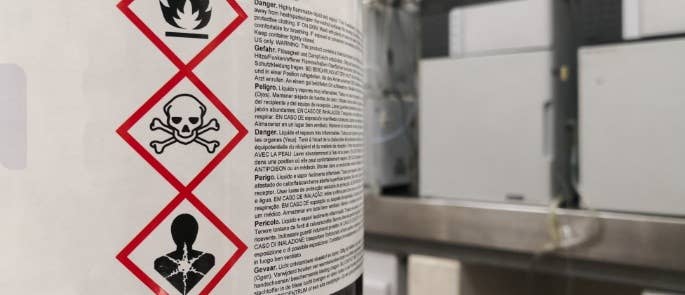How to Safely Store, Handle & Dispose of Corrosive Chemicals
Corrosive chemicals have excellent industrial applications, but they are highly reactive and can destroy or damage materials, such as living tissue, metal or wood. It may be possible to substitute out corrosive chemicals for less hazardous alternatives. However, where this is not possible, you must take precautions to ensure you store, handle and use corrosive chemicals as safely as possible.
Examples of Corrosive Substances
Most corrosive chemicals are acids or bases, but other classes of chemicals can also be corrosive. Therefore, it’s important that you are aware of the properties of any chemical that you use. You should know how to recognise hazard labels and understand the precautions you should take when handling them.
Below are some examples of corrosive chemicals that are widely used in industry:
Sodium Hydroxide
Sodium hydroxide is a commonly used corrosive base, with many industrial applications. For example, it’s featured in the soap and papermaking process and in the production of cosmetics. It is excellent at breaking down fats, which is ideal for soap making, but can be extremely damaging if it’s inhaled, swallowed or comes into contact with your skin or eyes.
Other corrosive bases include:
- Ammonium hydroxide.
- Potassium hydroxide.
Hydrofluoric Acid
Hydrofluoric (HF) acid is a very strong inorganic acid. It’s predominantly used in industrial processes such as metal cleaning, as its properties allow it to dissolve impurities and oxides from the surface of metals. HF is extremely corrosive, enough so that exposure to dilute samples can result in severe injuries. What’s worse is that these injuries may not be immediately visible or painful due to nerve damage. It is stored in special plastic containers, as it corrodes through almost everything.
Other corrosive acids include:
- Hydrochloric acid.
- Sulfuric acid.
- Nitric acid.
Prior to selecting a corrosive chemical for use in your process, you should always consider whether you can substitute it for a less hazardous substance. If you can, then you should.
Need a Course?
Our COSHH Training Course is designed to give workers knowledge of the health risks surrounding work with hazardous substances, including how to undertake a risk assessment for COSHH by identifying the risks and the control measures needed, and ensure that they understand how to work safely with hazardous substances.
Storage of Corrosive Chemicals
In general, you should store corrosive substances in separate storage areas, away from other materials, processing areas and handling areas. These storage areas should be designed to reduce the repercussions and damage caused by leaks, spillages or fire.
If you cannot store corrosive chemicals completely separately, you must store them alongside compatible materials. Never store incompatible materials together, as they can result in violent reactions which form heat and toxic gases.
You should store corrosive materials in areas which are:
- Well ventilated. Ventilation in storage areas, whether they are rooms or cabinets, helps remove any fumes at the source.
- Corrosive resistant. All flooring, walls and shelving should resist corrosive attacks, and flooring should be impenetrable. Small containers (< 250 litres) must be stored in corrosive resistant trays or special corrosive storage cabinets. Larger containers (> 250 litres) should be surrounded with dikes and kept in rooms with sills and ramps at door openings. If you use special storage cabinets, they must have lipped seals to appropriately contain any spills or leaks that might occur.
- Below eye level. Store corrosive chemicals below eye level to reduce the hazards should a vessel spill, leak or rupture.
- Supplied with appropriate and adequate firefighting equipment. Not all corrosive chemicals require the same firefighting equipment. For example, some chemicals might react adversely to water, making the fire worse. It’s important that you have appropriate equipment for all the chemicals in your storage facility.
- Fitted with suitable equipment and protection for the clean-up of spills.
- Properly labelled with warning signs.

Temperature
You must store all chemicals at an appropriate temperature, although the required temperature is not the same for all corrosive chemicals.
For example, you must consider the boiling and melting points of all the substances in storage, as ignoring these could result in dangerous, unsuitable storage conditions. If you store sealed corrosive liquids in direct sunlight or near other heat sources, you risk an increase in vapours and a build-up of pressure within the container. This can result in container damage, such as rupturing, or cause the liquid to shoot from the container when you open it. Both of these are very dangerous scenarios.
On the other hand, storing corrosive chemicals in too cool temperatures might result in the substance freezing. When liquids freeze, they expand and can damage the integrity of the container. For example, acetic acid freezes around 17°C, so keeping storage at 15°C could lead to disastrous consequences.
As a general rule, you should keep corrosive chemicals away from heat sources and direct sunlight, and should store them in cool, well-ventilated rooms.
Chemical Vessels
All chemicals should have a proper seal – and remain sealed unless in use – to reduce the risk of spills and the volume of vapours escaping. If decanting any chemicals, you must use a suitable receptacle (one that is resistant to the corrosive material) and label the new container appropriately to warn users of the contents and associated hazards.
You may need to periodically vent some chemicals to reduce the build-up of pressure caused by vapours inside the vessel, which could cause it to rupture. The safety data sheet (SDS) for the associated chemical should provide information on how often you should carry out venting. Only trained personnel can carry out the venting of a liquid and they must wear the appropriate PPE while undertaking the task.
You should only ever store the volume of chemicals that you need. Do not overstock, as this can make the repercussions of an accident much worse.
Safety Data Sheets
Reading and understanding the information in safety data sheets (SDSs) for every chemical that you store on the premises is vital. They provide important information that you cannot find on the container label and will help you to safely arrange your storage system to reduce hazards.
A safety data sheet provides information on:
- Identification of the substance or mixture.
- The name, address, and contact details of the manufacturer or supplier.
- Hazard identification of the chemical or chemicals in the substance, including hazards caused by reaction with any other substances.
- Composition details and information on ingredients, including the physical and chemical properties, stability, and reactivity.
- Toxicological information, including routes of entry to the body (inhalation, ingestion, skin or eye contact, or other routes).
- Ecological information.
- Accidental release measures.
- Transport, handling, storage, and disposal information.
- Exposure controls, personal protection, and regulatory information.
- First aid and fire-fighting measures.
It’s important that you understand all the information in these safety data sheets and use the advice they provide to store your corrosive chemicals safely.
Handling Corrosive Chemicals
Corrosive chemicals are dangerous; they can burn and destroy human tissue. Therefore, it’s important that you handle containers and substances diligently and carefully. Prior to moving containers of corrosive chemicals, you should ensure that they are not damaged in any way. You should not handle leaking, rusted or degraded containers and should deal with them appropriately.
Moving the vessels of corrosive chemicals by hand can be difficult and dangerous. Therefore, you should make use of drum cradles, carboy caddies or safety bottle carriers to move substances safely.
Personal Protective Equipment (PPE)
Before handling corrosive chemicals, you must always wear any required PPE. The MSDS for the substance should provide guidance on the PPE and controls required during handling.
The types of PPE you may need to handle chemicals include:
- Gloves. These must be chemical-resistant work gloves that afford protection for the specific chemicals on your premises. Discolouration to gloves means that their level of protection has been reduced and they need replacing immediately.
- Goggles. The goggles you choose must have side shields and have an appropriate level of protection from chemical splashes.
- Boots. Even if you don’t require specialist protective boots, you must always wear shoes that cover your feet and toes, and provide a degree of protection should you spill a corrosive substance. Therefore, no sandals, ballet pumps, fully canvas shoes etc.
- Impervious lab coat, coveralls, apron, protective suit etc. You should use some form of impervious clothing when handling corrosive chemicals. If contaminated, you should remove and clean them appropriately, or replace them if damaged.

Disposal of Corrosive Chemicals
Corrosive waste is hazardous, so you must always handle waste substances, pure or mixed, and the empty vessel safely and carefully. Never put waste chemicals in empty vessels. Even if they appear clean, they may still be contaminated and could cause an adverse reaction.
You must also never pour corrosive chemicals down the sink or drain. Instead, follow the manufacturer’s instructions in the MSDS to dispose of your chemicals safely, or use a hazardous waste collection and disposal company.
Just because a chemical is corrosive, it doesn’t mean that there are no other hazards associated with it: it might also be flammable, carcinogenic or toxic to aquatic. You must consult the relevant safety data sheet (SDS) before storing, handling, using or disposing of chemicals to ensure that you have the appropriate information, controls and PPE needed to carry out all processes safely.
What to Read Next:
- COSHH Hazards Symbols & Their Meanings
- What is A COSHH Assessment and Does My Workplace Need One?
- COSHH – A Guide to Employers’ and Employees’ Responsibilities
- Online COSHH Training











